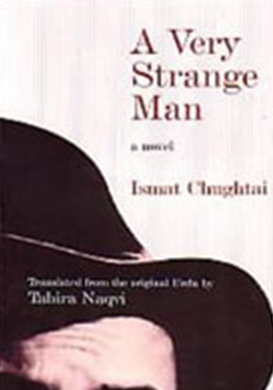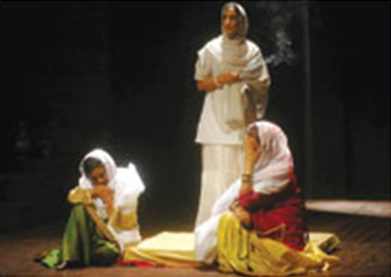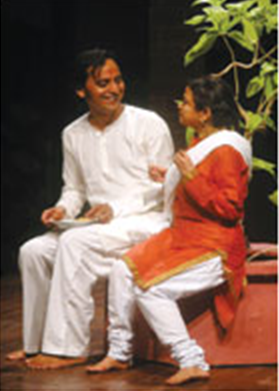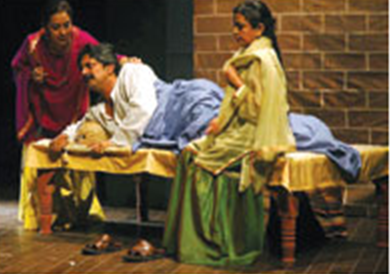Ismat Chughtai
(Created page with "{| class="wikitable" |- |colspan="0"|<div style="font-size:100%"> This is a collection of articles archived for the excellence of their content.<br/>You can help by converting...") |
|||
| Line 15: | Line 15: | ||
=Ismat Chughtai= | =Ismat Chughtai= | ||
| + | |||
| + | [http://dawn.com/ Dawn] | ||
Behind the silver screen | Behind the silver screen | ||
| Line 21: | Line 23: | ||
Reviewed by Saulat Pervez | Reviewed by Saulat Pervez | ||
| − | |||
| − | |||
[[File: Ismat Chughtai.png||frame|500px]] | [[File: Ismat Chughtai.png||frame|500px]] | ||
| Line 67: | Line 67: | ||
=Ismat Chughtai II= | =Ismat Chughtai II= | ||
| + | |||
| + | [http://dawn.com/ Dawn] | ||
Putting Chughtai on stage | Putting Chughtai on stage | ||
| Line 83: | Line 85: | ||
The stories in question are Kafir that revolves around a Muslim girl’s love for a Hindu boy whom she wants to marry, and Amarbail which unveils the true middle class Muslim woman and how she govern’s the lives of men in her life. After witnessing both the performances, the first thought that comes to mind is of a task well executed by the Tehrik-i-Niswan troupe. | The stories in question are Kafir that revolves around a Muslim girl’s love for a Hindu boy whom she wants to marry, and Amarbail which unveils the true middle class Muslim woman and how she govern’s the lives of men in her life. After witnessing both the performances, the first thought that comes to mind is of a task well executed by the Tehrik-i-Niswan troupe. | ||
| − | |||
| − | |||
The sweetness of the language used by the writer to depict that era in its original form and the direction by Anwer Jafri (Kafir) and Asma Mundrawala (Amarbail), as well as the up to the mark acting by Salim Meraj and Asma Mundrawala (Pushkar and Munni, respectively, in Kafir) and Imtiazi Phupoo/Najji Bua (Sheema Kermani), Shujaat Mian (Saif-i-Hasan), Qamar Ara (Mahvash Faruqi) and Noor Fatima (Asma Mundrawala) in Amarbail is definitely the plus point of both the productions. Even though Ismat’s work is perfect in itself and one doesn’t need to struggle too much while staging it, Tehrik-i-Niswan’s adaptation managed to bring out the true essence of Chughtai’s writings. | The sweetness of the language used by the writer to depict that era in its original form and the direction by Anwer Jafri (Kafir) and Asma Mundrawala (Amarbail), as well as the up to the mark acting by Salim Meraj and Asma Mundrawala (Pushkar and Munni, respectively, in Kafir) and Imtiazi Phupoo/Najji Bua (Sheema Kermani), Shujaat Mian (Saif-i-Hasan), Qamar Ara (Mahvash Faruqi) and Noor Fatima (Asma Mundrawala) in Amarbail is definitely the plus point of both the productions. Even though Ismat’s work is perfect in itself and one doesn’t need to struggle too much while staging it, Tehrik-i-Niswan’s adaptation managed to bring out the true essence of Chughtai’s writings. | ||
| Line 93: | Line 93: | ||
Anwer Jafri: You just do not find good scripts today. Besides, if one talks about television versus theatre adaptations of literature, firstly these are two different mediums and you cannot compare the two. Secondly, by bringing the literature of Ismat and/or Manto to stage, every director will bring his/her own interpretation to it. | Anwer Jafri: You just do not find good scripts today. Besides, if one talks about television versus theatre adaptations of literature, firstly these are two different mediums and you cannot compare the two. Secondly, by bringing the literature of Ismat and/or Manto to stage, every director will bring his/her own interpretation to it. | ||
| − | |||
| − | |||
Take a look at world theatre — every other person is picking up literature and presenting the same story according to their perspective. So why not tap on Urdu literature which has so much to offer? And no, we weren’t following a trend. We have been contemplating work on Ismat Chughtai. Writers such as Ismat are a treasure trove. Her short stories are written in a way that one can easily adapt it for theatre. | Take a look at world theatre — every other person is picking up literature and presenting the same story according to their perspective. So why not tap on Urdu literature which has so much to offer? And no, we weren’t following a trend. We have been contemplating work on Ismat Chughtai. Writers such as Ismat are a treasure trove. Her short stories are written in a way that one can easily adapt it for theatre. | ||
Both Kafir and Amarbail depict a time culture, language and era long gone. Today’s generation might not be able to relate to the ghararas, pandans and rista lagane wali bua? | Both Kafir and Amarbail depict a time culture, language and era long gone. Today’s generation might not be able to relate to the ghararas, pandans and rista lagane wali bua? | ||
| + | |||
| + | [[File: Ismat Chughtai II1.png|Ismat Chughtai |frame|500px]] | ||
AJ: The era of the pandan might have gone by but this is a part of our culture and was a part of our lives at some point. There is nothing wrong in recreating that time frame. As far as the language is concerned, if we do not revive it or keep it alive it will be lost forever. | AJ: The era of the pandan might have gone by but this is a part of our culture and was a part of our lives at some point. There is nothing wrong in recreating that time frame. As far as the language is concerned, if we do not revive it or keep it alive it will be lost forever. | ||
| Line 115: | Line 115: | ||
This project kicked off when we decided that this is the time to get serious about it as it. I wanted to maintain the narrative element in the play without really dramatising it beyond what I thought was necessary. For me, the storytelling approach was very important. | This project kicked off when we decided that this is the time to get serious about it as it. I wanted to maintain the narrative element in the play without really dramatising it beyond what I thought was necessary. For me, the storytelling approach was very important. | ||
| + | |||
| + | [[File: Ismat Chughtai II2.png|Ismat Chughtai |frame|500px]] | ||
How was the experience? | How was the experience? | ||
Revision as of 06:01, 4 January 2014
This is a collection of articles archived for the excellence of their content. Readers will be able to edit existing articles and post new articles directly |
Ismat Chughtai
Behind the silver screen
By Ismat Chughtai
Reviewed by Saulat Pervez
Urdu literature has a rich lineage of diverse authors whose writings have both entertained and infuriated generations but their readership has, nonetheless, been limited. For instance, these works have largely remained elusive for English readers due to the scarcity of translations, until recently.
Tahira Naqvi, a translator, writer, and Urdu language lecturer is among the new breed of translators who are actively working to bridge this gap. She has translated the works of Sa’adat Hasan Manto, Munshi Premchand, Khadija Mastoor, and Ismat Chughtai. A Very Strange Man is Naqvi’s latest offering of Urdu prose to the English readership.
Translated from the original novel Ajeeb Aadmi, it follows the journey of an unknown director as he tastes fame, love, depression, and finally, death. In the process, Chughtai skillfully weaves an unflinching critique of the film industry, making her readers starkly aware of the behind-the-curtain life in Bollywood — from one who lived and breathed it.
Indeed, Naqvi charts the connection between the Urdu literati and the Bombay film industry in her Introduction. She explains that the Progressive Writers’ Movement was very much linked with the film industry, as many of its writers earned their bread and butter by writing scripts for Indian movies. Chughtai herself was married to a film director, Shahid Latif, with whom she produced and co-directed six movies. Even after his death, she continued her association with the film world and produced six more pictures. She was the script writer of famous titles such as Ziddi, Buzdil, Sone ki Chiriya, and Garm Hawa, among others.
Hence, the subject matter of Ajeeb Aadmi is neither novel nor recreational for Chughtai. She focuses her mind’s lens on an obscure director, Dharam Dev, who catapults to fame and glory with the release of Bali, an innovative movie. His signature technique, touch, and style are touted and his genius is trumpeted all over the industry. He loves the limelight and soon, not only does he start his own production company, he also becomes the hero for most of his films — as was the trend in those days. Introduced as an ‘incorrigible lover,’ he nevertheless marries Mangala, a Bengali playback singer after she, bereft of his attention, attempts suicide.
Rumours abound of Dharam Dev’s affairs, but he manages to sidestep them and eventually Mangala is satisfied with her husband’s loyalty to her. Enter Zarina Jamal, a talented dancer from Hyderabad, as the heroine hired by Dharam Dev on a five-year contract and the story takes a predictable turn. Although Dharam Dev puts a lock on his heart more than once in the course of the story, the very thought of Zarina Jamal effortlessly becomes the key. Her evasiveness after submission is too much to bear and this man, the very strange man of the title, is willing to give up everything to win her back.
Readers look on in horror as he begins to undo his hard work, with random gasps of his genius here and there like the sputtering of a car before it dies. His life becomes a pendulum between fame and depression — the former being a temporary panacea. He seeks consolation in alcohol and a filmi tawa’if, but in the end, after a series of attempted suicides, he — just when he is so close to his objective — dies, leaving behind a mangled Mangala who has wreaked havoc with her life ever since her marriage fizzled out.
As this sorry tale unfolds, the reader is sickened by the depravity behind the glitter, so much so that it is difficult to continue reading but then one realises that this is the true aim of the book: to present the reality in all its gory details. We are being shown the tumultuous lives led by heroes, heroines, directors, producers, script writers, singers, and even the staff working on a set, beyond the silver screen. We are made to see how the fictitious story of a movie slowly creeps into actors’ lives — how the on-screen romance blossoms off-screen. Yet, we can also see how it wilts afterwards, with dangerous consequences for all the parties involved.
The storyline makes it clear that Ismat Chughtai was heavily influenced by the real-life love triangle of Guru Dutt, Geeta Dutt, and Waheeda Rehman. However, she refrains from making any direct references most likely for fear of a lawsuit. She does mention other contemporary artists such as Ashok Kumar, Dev Anand, Madhubala, Dilip Kumar, Lata, Rafi and even Shahid Latif at one point, which add to the realism in her story. Similarly, actual film titles and song lyrics are also interspersed in the narrative, with the same effect.
The plot itself is easily overtaken many times with Chughtai’s preoccupation with industry trends — from black money to publicity ploys and the ‘adoption’ of heroines by producers. It is this crisp commentary which keeps the narrative alive, more so than the lives of the main characters — after all, they simply become representative of the general picture and are put up as models of the destructive forces within the industry.
Naqvi deftly captures Chughtai’s spirit in A Very Strange Man. One can clearly hear the author’s voice echoing through the narrative. She also maintains an informal and spontaneous style, which makes the reader feel as if they are reading Urdu in English! Indeed, the text repeatedly jumps around — it goes off on a tirade and then returns in the next breath, so to speak, to continue the story. As a result, the reader must keep a vigilant eye for the ever-changing twists and turns in the novel because one never knows how suddenly a tangent will begin and when it will come to a dead stop.
Robert Frost once said, ‘Poetry gets lost in translation.’ While Tahira Naqvi has successfully circumvented this trap, one does wonder whether the title A Very Strange Man fully encapsulates the implications of Chughtai’s choice of Ajeeb Aadmi. After all, the term ‘aadmi’ in Urdu is used for both singular and plural — hence, could the author be putting Dharam Dev on the spotlight as an example of many others like him in the film industry? In fact, she points out other cases in the story like Dharam Dev’s where directors/producers leave their families for some young starlet, who in turn leaves them once she reaches her peak.
All in all, A Very Strange Man is a useful reminder for those of us who are enamoured by the ‘glossy’ lives of the glitterati. The reality behind the gossamer veils is not as luminous as the silver screen — and, at times, their real lives are stranger than the fiction they create.
A Very Strange Man
(Ajeeb Aadmi)
Translated by Tahira Naqvi
Women Unlimited, New Delhi, India
ISBN 88965-36-7
231pp. Indian Rs250
Ismat Chughtai II
Putting Chughtai on stage
Ismat Chughtai
An eminent Indian Urdu writer known for her indomitable spirit and fierce feministic views, Ismat Chughtai was a born rebel. Considered the grand dame of Urdu fiction and as one of the four pillars of modern Urdu short story (the other three being Saadat Hasan Manto, Krishan Chander and Rajinder Singh Bedi), her outspoken and controversial style of writing made her the passionate voice for the unheard.
Ismat has become an inspiration for the younger generation of writers, readers and intellectuals. Termed as classics in recent times, her short stories have often being staged for theatre as well as adapted for televsion.
Tehrik-i-Niswan
Known for consitently striving to raise awarness about women’s rights through the medium of theatre, Tehrik-i-Niswan spearheaded by Sheema Kermani, recently took two stories of the oft-titled rebilious witer, Ismat Chughtai.
The stories in question are Kafir that revolves around a Muslim girl’s love for a Hindu boy whom she wants to marry, and Amarbail which unveils the true middle class Muslim woman and how she govern’s the lives of men in her life. After witnessing both the performances, the first thought that comes to mind is of a task well executed by the Tehrik-i-Niswan troupe.
The sweetness of the language used by the writer to depict that era in its original form and the direction by Anwer Jafri (Kafir) and Asma Mundrawala (Amarbail), as well as the up to the mark acting by Salim Meraj and Asma Mundrawala (Pushkar and Munni, respectively, in Kafir) and Imtiazi Phupoo/Najji Bua (Sheema Kermani), Shujaat Mian (Saif-i-Hasan), Qamar Ara (Mahvash Faruqi) and Noor Fatima (Asma Mundrawala) in Amarbail is definitely the plus point of both the productions. Even though Ismat’s work is perfect in itself and one doesn’t need to struggle too much while staging it, Tehrik-i-Niswan’s adaptation managed to bring out the true essence of Chughtai’s writings.
Images managed to catch up with directors Anwer Jafri and Asma Mundrawala for an exclusive tête-à-tête after the performances.
Making a play on literature, be it for TV or stage, has become a trend. Has Tehrik followed such a trend. And why Ismat Chughtai?
Anwer Jafri: You just do not find good scripts today. Besides, if one talks about television versus theatre adaptations of literature, firstly these are two different mediums and you cannot compare the two. Secondly, by bringing the literature of Ismat and/or Manto to stage, every director will bring his/her own interpretation to it.
Take a look at world theatre — every other person is picking up literature and presenting the same story according to their perspective. So why not tap on Urdu literature which has so much to offer? And no, we weren’t following a trend. We have been contemplating work on Ismat Chughtai. Writers such as Ismat are a treasure trove. Her short stories are written in a way that one can easily adapt it for theatre.
Both Kafir and Amarbail depict a time culture, language and era long gone. Today’s generation might not be able to relate to the ghararas, pandans and rista lagane wali bua?
AJ: The era of the pandan might have gone by but this is a part of our culture and was a part of our lives at some point. There is nothing wrong in recreating that time frame. As far as the language is concerned, if we do not revive it or keep it alive it will be lost forever.
The Urdu spoken in those times had a sweetness which is getting maligned in today’s minglish-speaking society. Hence it is the responsibility of people like us to revive and keep the language alive through the medium of theatre.
Kafir talks about a Muslim girl and Hindu boy in love who want to get married. In India one can relate to it as Hindu/Muslim marriages take place there, but in Pakistan such an issue tends to raise eyebrows. Do you feel that the audiences here can relate to it?
AJ: If one reads the play carefully it says that thinking that only you are right and others aren’t leads to religious intolerance. When Ismat Apa wrote this play such alliances were not so common but happening. Besides, in the play the writer’s opinion about religion has also come out. Yes, some people might raise eyebrows but art is art; it doesn’t necessarily mean that it has to only talk about issues that are not controversial. In any case a certain topic can be considered controversial by some and may be relevant for others. Tehrik-i-Niswan has always taken risks.
In Kafir the writer has tackled this sensitive issue beautifully, depicting the arrogance of being a Muslim through the character of the girl Munni who, in the beginning, coins the name Kafir and keeps teasing her Hindu friend by this name.
As a theatre actor with a decade-long association with Tehrik-i-Niswan this is the first time that you have directed a play. What took you so long?
Asma Mundrawala: Many years ago, when I was studying abroad, I had seen a few plays which inspired me. I spent one summer reading Ismat Chugatai which was a huge learning experience. The language, the compelling vocabulary that she uses was all very captivating. When I came back I discussed it with my fellow actors at Tehrik and wanted to do something with it, but not really knowing what.
This project kicked off when we decided that this is the time to get serious about it as it. I wanted to maintain the narrative element in the play without really dramatising it beyond what I thought was necessary. For me, the storytelling approach was very important.
How was the experience?
AM: It was very scary but a learning one, nonetheless. I would like to add that had it not been the support of my actors and Sheema and Tehrik-i-Niswan I would not have been able to do this. It is one thing to want to do something, but it’s quite another to be able to get the support to actually do it.
Putting forth the same question that we asked the director of Kafir, why Ismat?
AM: There is no reason for picking Ismat. It is a piece of literature which was written during a certain period in time, and done so in a kind of playfulness that is very alive in the world even today. It had to be the way it is supposed to be, and not because it is in vogue.
The sets of both Kafir and Amarbail were very simple and basic. Would you have rather made it elaborate?
AM: I did not want a highly-detailed or realistic set as it was part-narrative, part-dramatisation. I wanted the set to work in a simplistic way without feeling like we are working in a playground.
You acted as well as directed Amarbail. How easy or difficult was it to juggle both?AM: It’s very difficult and I don’t know if I will be able to do that again. I love the story and couldn’t resist doing the role. Who knows, in the next production I might stay on the sidelines.
Is directing more creatively satisfying than being a mere actor?
Yes, certainly. Directing is a huge creative process. I look at it as an extension of my visual art practice. Also, the training in theatre has come in handy and has formed my work as a director in many ways. — U.M.




